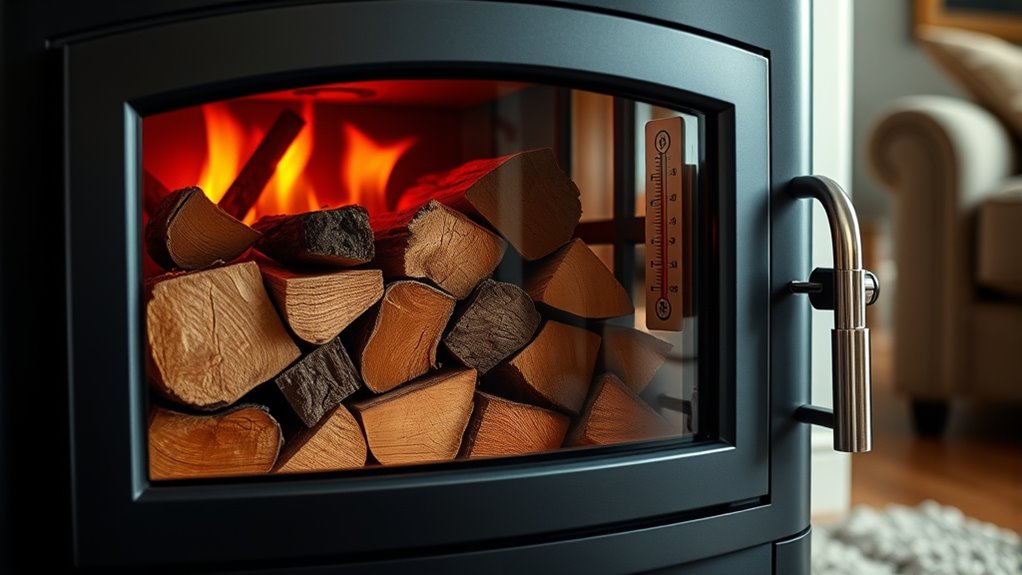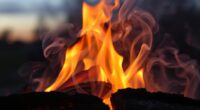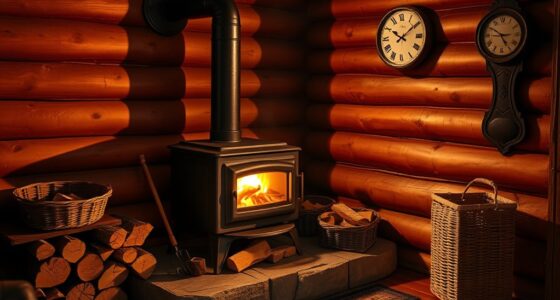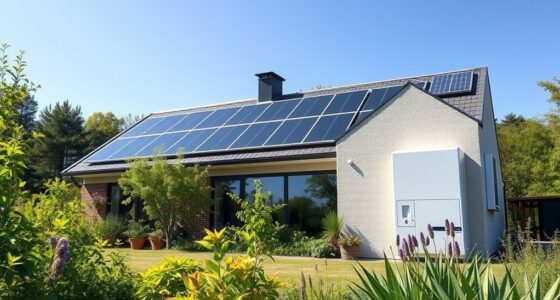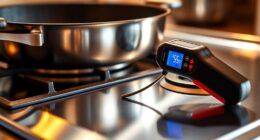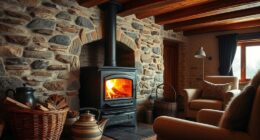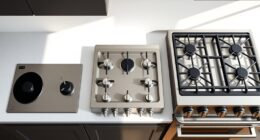To meet wood stove safety standards, you should select a stove with proper certifications like UL or EPA approval, inspect it regularly for damage, and make sure it fits correctly in your space. Maintain clearances from combustibles, clean chimneys to prevent creosote buildup, and follow installation guidelines carefully. Always use safety devices like smoke and CO detectors, and follow fire prevention practices during operation. Continue exploring to discover essential tips for safe, efficient wood stove use.
Key Takeaways
- Ensure wood stoves have UL or recognized testing approval and EPA certification for safety compliance.
- Maintain proper clearances: at least 36 inches from combustible walls and appropriate hearth extensions.
- Regularly inspect and clean chimneys to prevent creosote buildup and reduce fire risk.
- Install smoke and carbon monoxide detectors outside sleeping areas and on each level, testing monthly.
- Follow manufacturer guidelines and local codes for installation, venting, and operation safety standards.
Proper Selection and Inspection of Wood Stoves
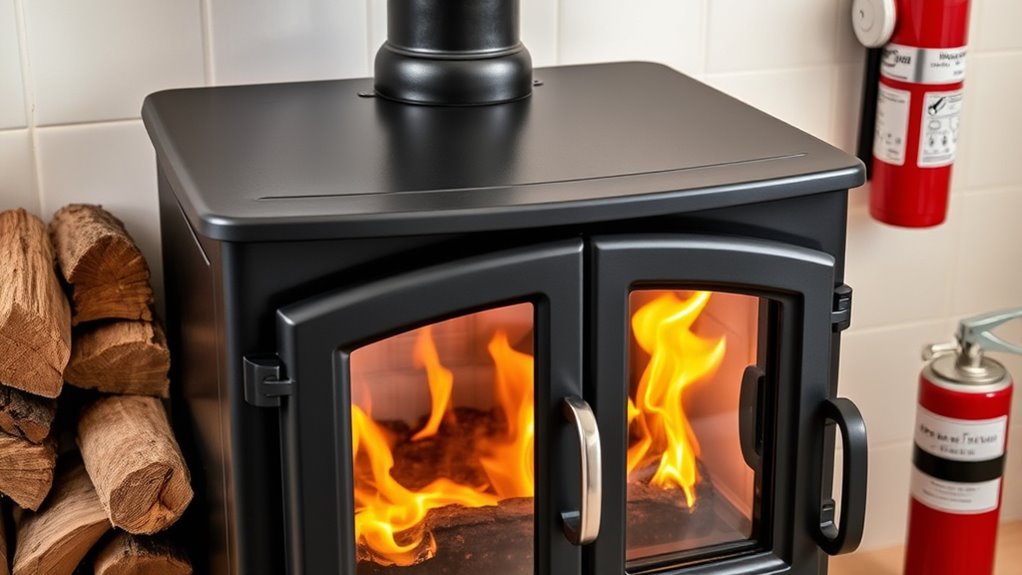
Choosing the right wood stove starts with careful inspection and selection. You want a wood stove inspected for cracks, defects, and all functional parts to guarantee safety and efficiency. Check the chimney and flue for creosote buildup, which can cause dangerous buildup and increase the risk of chimney fires. Make sure the stove fits properly within your fireplace opening and that the fire chamber or base is sturdy and intact. For masonry chimneys, verify they are in good condition to handle flue gases and sparks safely. Always select a stove with UL or recognized testing laboratory approval, confirming it meets safety standards. Additionally, ensure the stove is EPA-certified for reduced emissions and matches your heating needs in size and capacity. Proper stove operation and regular maintenance are also essential to prevent hazards and maximize efficiency. Regular cleaning and inspection of safety features can help identify potential issues before they become hazards, ensuring safe operation. Maintaining proper airflow and ventilation is crucial for combustion efficiency and safety. Staying informed about safety standards can further enhance your stove’s safe use and longevity.
Installation Guidelines and Clearance Requirements

Proper installation of your wood stove is essential for safety and efficiency, and it begins with following strict clearance guidelines. Maintain a minimum clearance of 36 inches from combustible walls or ceilings unless protected by approved heat shields or non-combustible barriers. Use non-combustible hearth extensions that extend at least 18 inches in front and 12 inches on the sides to protect the floor. Ensure flue pipes have clearance three times their diameter from combustible materials; heat shields can help reduce this distance when approved. When venting through walls, keep at least 12 inches clearance for brick chimneys or 9 inches for factory-built chimneys, with proper insulation and air space. Always adhere to manufacturer specifications and local installation requirements to guarantee safety and compliance. Additionally, be aware of family photoshoot fails that can occur if safety precautions are overlooked during installation. Proper installation techniques are vital to prevent hazards and ensure your stove operates safely over time. Staying informed about regulatory standards can also help you avoid potential violations and ensure your setup meets all safety codes. Incorporating safety equipment such as smoke and carbon monoxide detectors is also highly recommended to enhance overall safety.
Chimney and Venting System Safety Measures
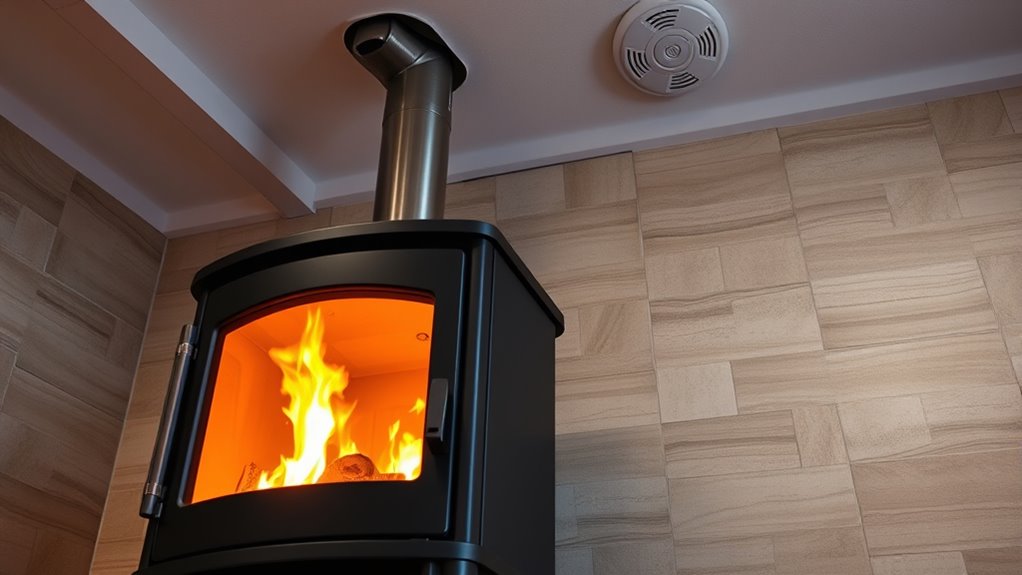
Ensuring your chimney and venting system is safe and effective starts with following key guidelines for installation and maintenance. Proper flue installation guarantees the chimney extends at least 3 feet above the roof and 2 feet higher than nearby structures, supporting chimney safety and draft. Regular chimney inspection and cleaning are crucial to remove creosote buildup, which can ignite and cause chimney fires. Use UL-listed chimneys and ensure joints are sealed with surface cement to prevent leaks. Maintaining proper clearance requirements and avoiding sharp bends in the venting system promote efficient operation and reduce creosote accumulation. Support your chimney adequately with proper chimney support systems, and prioritize chimney fire prevention by adhering to all safety standards. These measures help keep your system safe, efficient, and compliant. Additionally, choosing appropriate chimney names can enhance the aesthetic appeal and safety of your installation. Proper ventilation and airflow management are essential to prevent dangerous buildup of gases and ensure safe operation. Regularly monitoring venting system performance can help identify issues early and maintain optimal safety. Incorporating advanced safety features, such as carbon monoxide detectors, further enhances overall chimney system safety and peace of mind. Regular inspections also help identify potential hazards early, reducing the risk of dangerous incidents.
Operating Practices and Fire Prevention
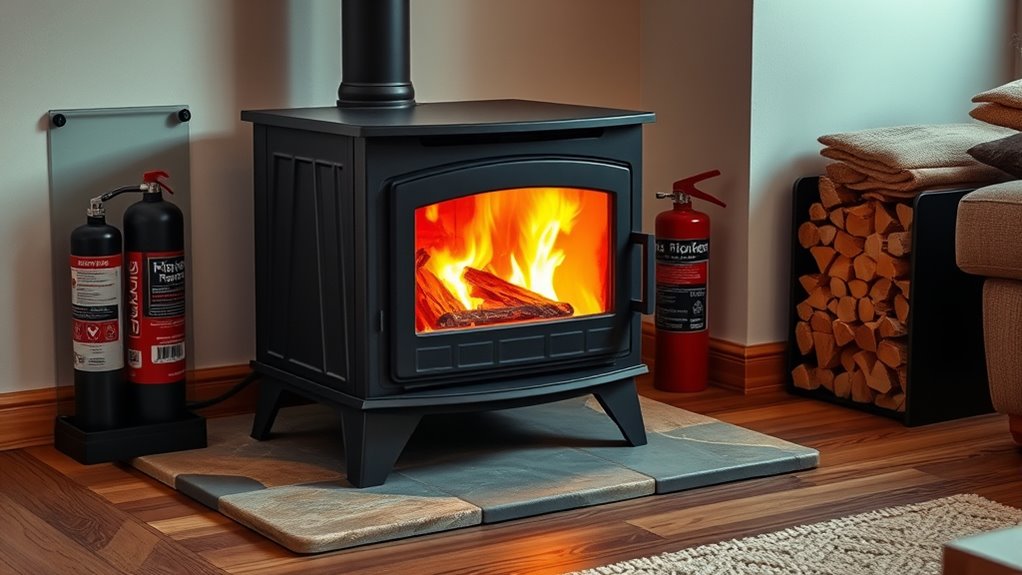
To prevent fires and operate your wood stove safely, it’s essential to follow proper practices every time you use it. Always open the damper before igniting a fire to ensure good airflow and prevent dangerous gases from building up. Build fires on a shallow ash bed to reflect heat and improve combustion efficiency. Regularly have a chimney sweep inspect and clean your flue to reduce creosote formation, which can cause a dangerous chimney fire. Maintain proper clearance between the stove and combustible walls to prevent heat damage. Use draft control and dampers to regulate burn rate; open them if the fire burns slowly or produces excess smoke. Ensuring your stove is equipped with proper safety features can further reduce risks and enhance fire prevention. Following these fire prevention tips helps reduce risks and keeps your home safe during stove operation.
Maintenance, Emergency Response, and Safety Devices

Regular maintenance of your wood stove and chimney is essential for safe operation and preventing fires. Schedule chimney inspections and stove pipe cleaning at least once per heating season to reduce creosote buildup, which can ignite and cause a chimney fire. Install smoke and carbon monoxide detectors outside sleeping areas and on each level of your home, testing them monthly to guarantee they work properly. Use a stovepipe thermometer to monitor flue temperatures, avoiding overheating. Have a chimney professional conduct annual inspections and professional cleaning to identify any damage or deterioration. In case of a chimney fire, immediately call 911, evacuate, and close the stove draft louvers and damper—never attempt to extinguish with water. Digital literacy programs can help seniors understand how to use safety devices and respond appropriately in emergencies. Proper Resources and Tools maintenance and safety devices save lives.
Frequently Asked Questions
What Is the 3:2-10 Rule for Wood Stoves?
You’re asking about the 3:2-10 rule, which guides how far your wood stove should be from combustible materials. You should maintain at least 3 inches of clearance on the sides, 2 inches at the back, and 10 inches in front. This spacing helps prevent fires, improves airflow, and ensures safe operation. Always follow these measurements and consider shields if you need closer clearances.
What Are the NFPA Guidelines for Wood Stoves?
Think of NFPA guidelines as the blueprint for a safe fire dance. You need a flue size no more than three times your stove’s outlet area, ensuring a smooth draft. Your chimney should rise at least 3 feet above the roof and 2 feet above nearby structures, like a tall flagpole. Regular inspections and UL-listed parts keep your fire performance safe and steady, preventing dangerous buildup or backdrafts.
How Far Does a Wood Stove Have to Be Away From a Wall?
You should keep your wood stove at least 36 inches away from a combustible wall unless you use approved heat shields or non-combustible barriers, which can diminish that distance to around 12 inches. If your wall is made of combustible materials, maintaining the 36-inch clearance is safest unless you install proper protective measures. Always check your local codes and manufacturer instructions to ensure compliance and safety.
What Are the Precautions for a Wood Burning Stove?
Imagine you’re in a sci-fi movie, and safety is your superpower. To keep your wood stove safe, follow manufacturer instructions and local fire codes. Maintain at least 36 inches of clearance or use heat shields. Regularly clean your chimney to prevent fires, burn seasoned hardwood, and build proper fires. Keep a fire extinguisher, smoke alarm, and CO detector nearby—these are your essential safety gadgets for peace of mind.
Conclusion
By following proper safety standards, you reduce the risk of house fires caused by wood stoves, which account for over 25% of home heating fires annually. Regular inspections, correct installation, and safe operating practices are key to protecting your home and loved ones. Remember, a well-maintained stove with functioning safety devices can make all the difference. Stay vigilant, stay safe, and enjoy the warmth of your stove without worry.

